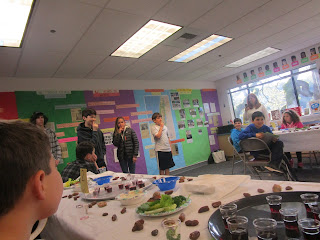Yesterday, we took a close look at the Pesach Haggadah and the 15 steps of the seder ceremony in it. As we explored each step, I shared with the students the rituals which have been traditionally performed by Jews all over the world, to remind us of our escape from slavery in Egypt to freedom in the Promised Land.
Once we had reviewed all 15 steps, we then explored each step again. This time, I first read out loud each of the step titles and asked the students if they noticed anything interesting about the names. Almost all the students could hear that they formed an ABCB rhyming pattern, which made it easier for all the participants to remember which step came next. I then shared the reason we would be going through the rituals of each step again - this time, I would be asking the students, based upon what we have learned to date about the Crypto-Jews in Spain (those Jews who had converted to Christianity in order to be allowed to stay in Spain after 1492, but who secretly continued to observe Jewish holidays and rituals), how they might have performed the ritual, since they had no rabbis, synagogues, schools, or even haggadot to tell them how to do so. I shared that the Crypto-Jews did recall all 15 steps, thanks to the rhyming pattern of the names of the steps, but that was all they had.
As it turns out, they did recall almost all the steps since the names were self-explanatory. For example "Kadesh" (the first step) is the Aramaic word for "Kiddush" (the blessing over the wine), which they could recall; "U'r'chatz" (literally, "And Wash") involved the washing of hands. But there were three steps which they re-interpreted from their own experience:
1) "Korech" (the preparing of a sandwich made of two pieces of matza with horseradish between them as Rabbi Hillel used to make, and in some haggadot with charoset in the sandwich as well. They knew the term "Korech" was Aramaic for "sandwich," but for them it was not a sandwich to be eaten, but instead a time for each participant to share how s/he felt "sandwiched" between Judaism and Christianity, always fearing that they might perform a Jewish gesture or chant a Hebrew phrase during Christian mass by mistake, and thus be discovered and arrested. They bemoaned the fact that they were forgetting central beliefs of Judaism as well as rituals.
2) "Tzafoon" (meaning "Hidden" in Aramaic) is the step immediately following the Meal, when children search for the half piece of matza that was hidden by the head of the household during the 4th step ("Yachatz") of the ceremony, and, when found, is ransomed for a prize. For the Crypto-Jews, it was not an object that was hidden, but they, themselves. Again, they would share with each other how it felt to always have to look over their shoulders, wondering if the King's or Church's soldiers or spies would discover their true, hidden selves, and if any day that they awoke in their own beds in the morning, might be their last day of freedom before being arrested as a "Judaizer."
3) "Hallel" (meaning Praise), near the end of the ceremony, is when we sing songs of praise to God. But they couldn't recall these songs, and so one by one, each participant would say one or two words of praise to God.
The seder plate also looked very different at a Crypto-Jewish seder: there was no charoset (the mixture of wine, nuts, cinnamon and apples that most of us are familiar with in the U.S. today), and they used Romaine lettuce leaves to represent Maror (the bitter herb).
I ended our lesson, by teaching the students two songs sung at the Crypto-Jewish seder: the Sepharadi melody for "Kadesh, U'r'chatz" (the names of the 15 steps put to a beautiful melody), and
"Un Cavritico" (A Little Goat). This second song is the Ladino (Judeo-Spanish) version of "Chad Gadya," the very last song we sing at the seder. This is an allegorical song written in Europe in the late Middle Ages, in a very poor (grammatically-speaking) Aramaic. Because it describes how the enemies of Israel have always tried to destroy our nation, Crypto-Jews interpreted the song from their own experience, with the "cavritico" being themselves. We'll be singing both these songs during our Crypto-Jewish seder, which we'll be re-enacting this coming Sunday in class, together with Shira students who have also been studying about the Crypto-Jews of Spain.
We finished our session with a Creative Tefillah, led by sixth graders from all 3 tracks. David was our Edot representative.
Before beginning the actual prayer service, Rabbi Miller asked the sixth graders who would be leading the creative tefillah to come up and lead us in singing "Pharoah, Pharoah" in honor of Pesach, which is just a little over two weeks away.
Then Rabbi Miller introduced the theme our sixth graders had chosen.
And here is David introducing the "Avot v'Imahot" blessing of the Amidah:
A big YASHER KO'ACH to David and all the sixth grade prayer leaders for helping to thread our major prayers into the theme of "TV shows."






















































